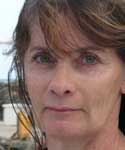
Margaret Muir
I am a big fan of both Margaret Muir and Linda Collison. Both are marvelous writers – skilled story tellers whose writing about the Age of Sail has both an immediacy and an understated authenticity that draws the reader into their books. (Perhaps not surprisingly, both have sailed as crew on square rigged ships.) If you are not familiar with Muir or Collison check out our review of Muir’s Floating Gold and Collison’s Surgeon’s Mate and Star Crossed.

Linda Collison
Linda Collison recently talked with Margaret Muir about sailing, writing, Tasmania and goats. Reposted from Linda’s blog, Sea of Words, with permission.
A conversation with novelist and Tasmanian historian, Margaret Muir
Throughout our writing lives we’re inspired by other authors. I’ve recently had the pleasure of discovering Tasmanian novelist and historian, Margaret Muir.
Margaret Muir is the author of five novels. Her latest, Floating Gold, is an age-of-sail nautical adventure set mainly in the Southern Ocean in 1802.
LC: Marg, after reading Floating Gold I have to say you seem quite at home aboard a British frigate in the early 19th century. The details you smoothly incorporated brought it alive for me. Can you tell us how you acquired such a working knowledge of shipboard life during the age-of-sail?
Marg: As far as I know, there is no Age-of-Sail 101 which provides instant qualifications in life aboard a fighting ship in the year 1800, so for me acquiring that knowledge has been a lengthy process, and it’s a journey which is still continuing. Though I served my ‘apprenticeship’ crewing on tall ships, my knowledge of the British Navy, of sea battles and shipboard life has been largely from books – mainly non-fiction. Primary source material is particularly valuable and intriguing, and there are many modern publications such as N. A. M. Rodgers, The Wooden World and Roy & Lesley Adkins, Jack Tar which describe every almost aspect of shipboard life. Reading the classic maritime fiction of Forester and O’Brian not only enhanced my knowledge but allowed me to sense the atmosphere of shipboard life. Over the years, I’ve also walked the decks of several tall ships and wandered through maritime museums around the world. But I attribute most of my insight to being part of the crew of a square rigger. For a female who had spent her working life looking through the lens of a microscope, the 360 degree view from the top of a ship’s mast was, for a long time, only a pipe-dream. However, when I was made redundant from my job, I decided it was time to live that dream.
LC: What was it like, living that dream?
Marg: I shall never forget my first voyage. Not quite knowing what to expect, I signed on as trainee crew for a 12-day voyage on the STS Leeuwin. Along with 39 others, I arrived in Exmouth (Western Australia) at mid-day ready to join the ship. It was anchored offshore. But the seas were rough and it was impossible to sail out to her. We waited on the wharf all afternoon for the wind to die and the sea to calm, but that never happened. Finally, at 8pm in pitch darkness, we were issued life jackets and ushered into small rubber dinghies which carried us out over the black sea. Having to leap from the dinghy which was pitching and rolling violently, grab for a rope ladder and clamber aboard, was a scary introduction to a sailor’s life.
LC: I can relate! Sailing isn’t always pleasant, for sure. And the sea is a harsh teacher at times.
Marg: An early lesson I learned was about seasickness. (At least I console myself with the fact that Nelson and many other great sailors suffered in this manner.) But once that feeling passed, the magic of tall ship sailing took over and I was hooked. Sailing north on the sparkling waters of the Indian Ocean, I learned the ropes (literally); their position on the pin rails, and when to haul and when to ease. I sat watch through the night and witnessed the marine bio-luminescence, and in the morning I holystoned the deck. But taking the helm of a tall ship under full sail was the best experience. As we entered Dampier harbour, I remember steering the ship between an oil rig and a tanker; listening to the calls from the captain; keeping one eye on the compass, and feeling 10 feet tall. My learning continued with more voyages on the Leeuwin and numerous day sails. I have to admit, I’m not a topmast man as I have no head for heights, however I accepted the challenge to climb the mainmast (33m/ 108 ft) to read the plaque on the top. These days, I don’t go aloft but am happy to serve on deck. On moving to Tasmania (41 degrees south) in 2007, I joined the Sail Training Association and became a member of the crew of the Lady Nelson.
LC: Lady Nelson, the replica ship? Can you tell us more about that experience?
Marg: She’s a tiny colonial brig– the original built in Deptford in 1789. My first sail with the Lady was a 5 day voyage half way around the rugged coast of Tasmania. I managed to paint Bass Strait green for the first 24 hours (but I was not alone) and what an unforgettable voyage it was. When I sail, it’s like stepping back into history – I only have to close my eyes and I’m on deck with the early settlers, or convicts, or sailors of the early 1800s.
LC: What else inspires you? How else did you research Floating Gold?
Marg: As I mentioned, I love to visit maritime museums. These offer a wealth of knowledge. But my favourite is the historic dockyard at Portsmouth. When I walked the gun decks of HMS Victory I tried to imagine the noise, the smoke and stench, not to mention the litter of dead and dying when the great ship was engaged in battle. It was awe inspiring and unforgettable. It has taken me 10 years to gain the knowledge I have, and my education is still ongoing. But apart from sailing and reading, the things which have helped me learn are my love of history and enthusiasm for the era, a conscious desire to step back in time, and above all a love of the sea in all its changing moods.
LC: Marg, Don’t I know you from a former life? Weren’t we shipmates in a previous century? All kidding aside, we have a lot in common but you’ve taken the path further than I have. And you have written five novels so far, is that correct?
Marg: Floating Gold was my fifth novel, published originally in UK.
LC: Tell me more about Margaret Muir the author. How long have you been a writer? What propelled you along that path?
Marg: Unlike most authors, my adventure into writing began fairly late in life. On being made redundant in the mid 90s from a career in cytopathology, I soon discovered I had the time to do the things I had previously only dreamed of – one was sail on a tall ship, another was to breed goats, and the third to write.
LC: Goats?
Marg: The goats came first and the writing followed. When I first put pen to paper it was as editor of a local goat association’s newsletter, but scratching around for interesting snippets sparked my enthusiasm for writing and led me to a correspondence course in freelance journalism. From there, I wrote articles for various newspapers and magazines and a correspondence course in writing for children followed but with no publishing success. In 2001, undeterred and still aiming for improvement, I embarked on a BA (Creative Writing) and it was during my three years of study that I first sailed on a tall ship. Also at this time, I cruised half way around the world, met Peter on a ship, and began writing my first novel, Sea Dust. Peter and I had much in common and apart from him being my soul mate, he quickly became my writing partner, critic and editor. But three years later, Peter died in a road accident and my writing dried up.
LC: That must have been crushing for you. How did you overcome the devastation?
Marg: Having lived for 30 years in Western Australia (born UK), I needed a change of scene and didn’t think twice about pulling up roots and moving. During a fleeting visit to Tasmania, I fell in love with the island’s rugged beauty and vast wilderness areas, so I headed east. Originally called Van Diemen’s Land, Tasmania was a British penal colony in the 1800s and its past is stained with the blood of convicts, cannibals, aborigines and bushrangers. Shortly after arriving, I learned of the ‘Gentleman Bushranger’, Matthew Brady – hung in Hobart Town in 1825. His biography has been told several times mainly by academics but I wanted to retell it in a fictionalised narrative form adhering to the facts but bringing the character and colonial era to life. Anxious to learn more of Van Diemen’s Land’s history, I enrolled at the University of Tasmania and will complete my course at the end of this year.
LC: That sounds exciting! I’m not holding you to anything, but what will you be writing five or ten years from now?
Marg: Along with Matthew Brady’s story, I will continue writing. Having thoroughly enjoyed creating the characters of Captain Quintrell, Mr Parry and the foremast jacks who made up the crew of Elusive, I believe the time has come for them to sail again (though I doubt HM frigate Elusive will make it out of the yard at Deptford). Having recently republished all my novels in paperback, I feel the sky is the limit. I love to learn and I love to write, and I see myself doing both for many years to come.
LC: It’s been a pleasure, Marg, and very inspiring for me personally. I look forward to reading more of your work! .
Margaret Muir’s books are available from Amazon.com or discounted at Spotlight on MARGARET MUIR. See also Margaret Muir.
Read more about her latest novel at FLOATING GOLD – age-of-sail nautical fiction adventure

Pingback: Age Of Sail 2 | Boating